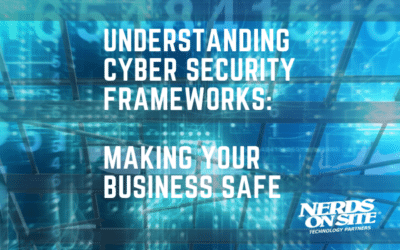What is a cybersecurity audit?
A cybersecurity audit focuses on evaluating your current cyber security plan; this could be the cyber security plan required by your industry, such as HIPAA compliance or PCI-DSS. It can also include one that you manage internally. A cybersecurity audit will highlight gaps in your plan and help you prioritize further action to improve your cyberinfrastructure & data security.
Article Contents
The cybersecurity audit should be conducted per industry standards, such as the National Institute of Standards and Technology (NIST) Cyber Security Framework.
How do cybersecurity audits differ from a cybersecurity assessment?
A cybersecurity audit will review and build on your existing cyber security plan. In contrast, a cybersecurity assessment will determine what you need to create a plan.
A cyber security assessment is the first step in any cyber security plan. It will highlight what your business needs to do to protect itself from cyberattacks. The cyber security assessment should include:
- Cyber risk analysis.
- An evaluation of cyber threats to your business.
- A review of your cyber business controls.
- Recommend cyber security controls for you to implement.
Our article titled “Business Cyber Security: What you need to know” covers more information about cyber security plans.
The following cybersecurity audit steps will help determine your business’ cyber-readiness and identify areas for improvement. Please note that this article is designed to be easily understood and should not replace a qualified auditor when securing your business.
Cyber security Audit Step 1: Evaluate your current cyber security plan
This stage focuses on evaluating whether or not there are any weaknesses within your cyber security plan. It includes looking into your business’s cyber security plan, security policies, and procedures. Your plan may consist of cyber-incident response plans, data backup plans, remediation plans, incident reporting policies, security awareness training plans, etc.
Current plans should be reviewed to ensure they are current and fit for purpose. Any associated personnel should be aware of any responsibilities they may have.
If you want more information on business cyber security plans, please review our article titled “Business Cyber Security: What you need to know.”
“This stage focuses on evaluating whether or not there are any weaknesses within your existing cyber security plan”
Cyber security Audit Step 2: Inventory all business-owned devices and devices connected to the network
So that you know what assets need to be protected, you should inventory your business to identify each system, application, network element, and device – both inside and outside your business’s perimeter. Every device should be tagged with a business sticker, logged, and reviewed against any existing inventory lists you may have.
The next step is to inventory every device connected to your network, including desktops, laptops, servers, routers, switches, firewalls, printers, etc. Once collected, you need to verify that all devices connected to your network are authorized.
As discussed in our blog post titled “Business Cyber Security: What you need to know,” it is crucial that you do not allow personal devices to connect to a business network.
If you find any devices on your property or network that you cannot verify, consider calling a professional for review.
“An inventory of every single device that your business owns and connected to your network.”
Cyber security Audit Step 3: protect your data security and inventory all accessible accounts
It is essential to maintain and review a database of privileged (Administrator) and regular users that can access your business’s data. As part of the cyber security audit, you should verify that privileged accounts are assigned to the correct personnel. Under no circumstances should non-IT staff have this access. You should also consider checking if all regular users are still active personnel. As an extra layer of protection against credential theft, we recommend reviewing IP Logs for all accounts.
“Identify all accounts and users that can connect to your business systems.”
Cyber security Audit Step 4: Identify cyber risks for your business model and industry
The cyber security audit process needs to include identifying cyber threats that could impact your cyber infrastructure’s confidentiality, integrity, or availability. It would be best to consider cyber threats in terms of their likelihood and possible business impact so that you can prioritize them during cyber security planning. Some examples of threats include:
- Denial of Service – A cyberattack that floods the target system with redundant data, rendering it unable to fulfill legitimate requests.
- Customer Data Compromise – Disclose or steal private data held by an organization, typically through hacking.
- Insider Threat – Intentional actions by current cyber security employees or cyber security contractors to undermine an organization’s cyber security.
- Malicious code – A cyber security spyware that can be delivered via a malicious email attachment or downloaded after clicking on an infected hyperlink.
- Social engineering – The act of manipulating people into performing actions or disclosing confidential information to gain access to the target system.
It is recommended to identify cyber-risks present within your business model and industry. For example, retail businesses may be at a higher risk of social engineering attacks, or companies that utilize a work-from-home model may have more risks associated with credential theft. Once these potential risks have been identified, you may be able to create a plan to help mitigate them, for example, phishing or social engineering tests.
“Identify cyber-risks present within your business model and industry.”
Cyber security Audit Step 5: Implement security controls, tools, and technologies
Next, you need to evaluate whether cyber resilience tools and technologies are required. Several security controls are available, including advanced anti-virus & vulnerability scanners, firewalls, and security operations centers (SOCs) with security monitoring capabilities. You should then use cyber audit results – collected during the first five steps – to determine how these new technologies could assist you in implementing further security controls and securing your business.
One of the best ways businesses can protect themselves is by implementing Zero Trust Networking. Zero Trust is a security model that eliminates the traditional idea of trust-by-default in computer systems. In a Zero Trust environment, every user and device is treated as potentially untrustworthy until proven otherwise. An employee clicking on phishing or malicious links would no longer be enough for an attacker to access your systems. In addition, the technology can help reduce latency and improve the performance of your business systems.
A business-friendly cyber security option you may want to consider is the SME Edge. A proven networking defense tool backed by Adam:Networks Zero Trust; Our patented AI technology automatically secures all of your business data against hackers, ransomware, or phishing attacks. Additionally, the SME Edge comes with managed business-grade networking equipment, and a secure encasement, and we can also guarantee a 99.999% business internet uptime.
“You need cyber resilience tools and technologies that can reduce cyber security vulnerabilities.”
Cyber security Audit Step 6: Review cyber security budgets, spending, and existing tools
It is crucial to review the cyber security budget and current cybersecurity expenditures within your business, ensuring that budgets are sufficient enough to cover all recommendations identified during the cyber security audit.
Periodically, you should also review your organization’s cyber resilience tools that your business has in place. It is essential to determine how well existing systems are working, whether they are still fit for purpose, and if more effective solutions exist. This step can help your business ensure that you’re getting the best value from your existing cyber security program.
“Review cyber security budgets & cyber security spending to ensure the money is being spent effectively.”
Cyber security Audit Step 7: Perform cyber security audits regularly
Last but not least, you need to conduct cybersecurity audits as a regular process. Even after the initial cyber security plan has been created and cyber-resilience strategies have been implemented. Businesses that want the best cyber security should perform cybersecurity audits at least every six months; however, annual cybersecurity audits are the industry standard.
“It is vital to conduct cyber-security audits regularly.”
The above steps represent a quick introduction to cybersecurity audits. Although some businesses may not have the required experience for a comprehensive audit, it is still possible to gain essential information on improving your business’s data security, policies, and network security. Suppose this is the first time auditing your cyber security plan. In that case, we recommend bringing in a professional, Nerds On Site, to help complete a comprehensive Cyber Security Audit for your business.











